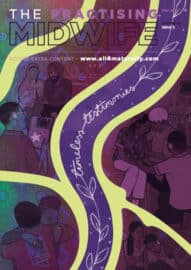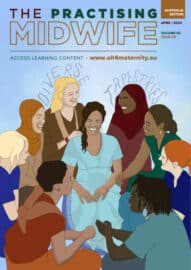No More ‘Hands off the Breech’
Shawn Walker – Midwifery Lecturer, King’s College London/Consultant Breech Specialist Midwife, Guy’s and St Thomas’ NHS Foundation Trust Director, Breech Birth Network, CIC
Published in The Practising Midwife - Volume 23 Issue 6 June 2020 https://doi.org/10.55975/YPKW4847
Introduction
This year, two new breech research reports are published alongside each other in Birth: Issues in Perinatal Care. The first is ‘Practical insight into upright breech birth from birth videos: a structured analysis’, by Dr Anke Reitter of Frankfurt, myself and midwife Alexandra Halliday.1 This paper contains my Physiological Breech Birth Algorithm, which summarises a problem-solving approach to teaching and using breech skills,2 alongside the evidence that underpins it. The algorithm has been refined over the last two years, with feedback from those who are attending physiological breech births regularly (see figure 1).
The second, ‘Face-to-pubes rotational manoeuvre for bilateral nuchal arms in a vaginal breech birth, resolved in an upright maternal position: A Case Report’, is by myself and Emma Spillane. Below I will discuss some key areas of breech practice I feel should be reconsidered in light of this new evidence.
No more ‘hands off the breech!’

Figure 1: Physiological Breech Birth Algorithm
This is arguably the most misconstrued and misapplied mantra in breech birth. Even Mary Cronk, the originator of the phrase,3 said she wished she had never said it. It was meant to stop health professionals from trying to pull babies out and causing trouble as a result. But she could never have anticipated how much it would inhibit professionals from putting their hands ON when necessary. Our latest research shows that most upright breech births occur within three minutes of the birth of the fetal pelvis,1 even when manoeuvres are used.
Midwifery is forever indebted to the work Mary and Jane Evans4 did to keep breech skills alive in the wake of the Term Breech Trial. I first got involved with breech teaching by supporting Mary in some of the final study days that she delivered. Mary was also fond of saying that she tended to be a bit more scissor-happy with a breech birth, meaning she did not hesitate to cut an episiotomy if the birth was not progressing quickly once the buttocks were on the perineum. Unsurprisingly, this has not become a mantra. But Mary knew both patience and assertive action were essential for safe breech birth.
For the last five years, I have used the phrases, ‘respect the mechanism’ and ‘restore the mechanism’5 instead of ‘hands off the breech’. The progress of a breech birth can be assessed according to what is ‘normal for breech’.1 If the birth deviates from this, the attendant’s job is to assist it to where it should be.
No more ‘just breathe… wait for the next contraction’

Figure 2: Flat hands and face-to-pubes rotational manoeuvre. Illustration by Katherine Gilmartin
If you were giving birth alone, and your baby was half out of you – would you resist the urge to push? No! All that pressure on your perineum? You would be pushing, wiggling, willing that child out of you because you would know it all depends on you. Only when women have absorbed the message that someone else is going to deliver their baby for them, when someone else has instructed them to ignore their body’s signals, or when anaesthesia interferes with these signals, will this not happen in an attended breech birth.
A breech birth is time sensitive. From the time the buttocks are on the perineum, cord compression is likely, and accurate measurement of the fetal heartrate is difficult. In the videos we analysed, once the baby begins to emerge, most women pause for only about 20 seconds to catch their breath before continuing to push, effectively, without a contraction – unless instructed to just breathe…
Instructing someone to resist an urge to push is an intervention, an interruption. With the baby half-out, the uterus is mostly empty. Contractions will space out, and the uterus will begin to prepare for third stage. You could be waiting five minutes or more, and the placenta may detach with the next big contraction.
Encouraging someone to push or wiggle (#GiveItAWiggle) is also an intervention. It is very effective to determine whether a minor delay can be resolved by maternal movement and effort alone. If not, obstruction requiring hands-on assistance is likely.
But if you find yourself saying: ‘Push! Harder!’ – stop. Take a deep breath. Analyse what the problem is and restore the mechanism. For example, if the baby’s pelvis remains sacrum transverse, shoulders in the anterior-posterior diameter, following descent to the nipple/scapula line, telling someone to push harder or to wait for the next contraction will waste valuable time. One or both arms are caught above the inlet to the pelvis, and rotational manoeuvres are very likely needed1,6 (see figures 2 and 3).
No more requiring supine positioning

Figure 3: Illustration by Merlin Strangeway
In our video study, women were assisted to convert to a supine position in two out of 42 births, and this also occurred in our case study. In all cases, conversion to supine for assistance occurred within seconds and did not delay the use of further manoeuvres or forceps for the aftercoming head.
Women giving birth to breech babies at term should have the same freedom of movement to attempt an optimal birth as women giving birth to cephalic babies.7 As per the Royal College of Obstetricians and Gynaecologists guideline,8 women should be informed that they may be asked to change position if required for assistance.

Figure 3: Illustration by Merlin Strangeway
But even if attendants only know manoeuvres for supine birth positions, this should no longer prevent women from maximising the chances that their baby will be born without the need for any assistance by beginning in an upright (kneeling, birthing stool, standing etc.) position.
No more fearing the Moro reflex
Although a startle/Moro reflex has traditionally been blamed for arm entrapment,9 I cannot locate a research basis for this assumption. I can, however, provide video evidence that even in births where no touching of the baby, not even a vaginal examination, has occurred, arm entrapment still occurs. Sadly, while debriefing many bad outcomes, I have observed many health professionals blame themselves for having potentially caused complications by touching the baby too soon, when it is clear to me that the birth would have benefited from assistance sooner than it was actually provided.
Let me offer a different way of looking at the role of neonatal reflexes in a breech birth. The mid-line clasping (true Moro reflex) and full body flexion recoil exhibited by a neurologically intact infant in an upright breech birth appears in our data to assist upright breech births. Another video research team, Rousseau et al10 recorded 75 videos of newborn behaviour during the Moro reflex immediately after birth. They distinguished the Startle Reflex, a sudden extension-adduction of both arms, from a true Moro Reflex, the subsequent extension-abduction of the arms to mid-line, occurring in slightly tonic shaped arc movements in co-ordination with leg movements. Moro called this an “Umklammerungreflex” (embracing or clasping reflex).11 As with Moro’s original description, Rousseau’s team observed this most often with the infant placed in a supine position, and frequently with enough force to fling the infant into a flexed lateral position.
The slight supine extension that occurs as an infant faces up in an upright breech birth may explain how the ‘tummy crunch’ described by others12 and observed in our data is triggered in uncompromised babies. While I am an advocate of non-interference until it is needed, I am much more concerned about the absence of neonatal reflexes than the potential to trigger them. A healthy baby will assist her or his own birth, pulling the arms midline and flexing the head, recoiling back into a fetal position. A baby that is compromised in any way will very likely need your hands-on assistance.
No more concluding serious case reviews with ‘it should have been a caesarean section…’
Well-informed, intelligent women choose to attempt a vaginal breech birth.14 The research suggests 35-50% make this choice with balanced and supportive counselling.7,15 When an adverse outcome occurs, it can be tempting to assume that it could have been prevented by better informing the mother about the risks of vaginal birth. But assuming that a woman has not been adequately counselled has dangerous and unwanted consequences. First, it undermines the professionalism of those involved in her care, frightening other professionals from offering women balanced counselling and choice over mode of birth. But most importantly, it shuts down the conversation about what could have made a difference in this birth, thereby preventing learning that can improve the outcomes in future breech births. And we really need to have these conversations, as hard as they are.
Most adverse outcomes with term breech births occur because of delay and consequent hypoxia. While delay is cautioned against, it is rarely well defined in teaching and guidelines. At least one hospital guideline and one university I am aware of have taught for several years that a breech birth can take five minutes for the legs, five minutes for the arms and five minutes for the head. Compare this to the median of fewer than two minutes total we observed among 42 actual videos. When recommendations not based on evidence make it into guidelines and textbooks, undoing them can be difficult.
Jean Sutton, original teacher of Optimal Foetal Positioning, once said: ‘One of the hardest things to do is to forgive yourself for what you did before you learned how to do better.’ Learning to do better will always require compassion, forgiveness and courage.
No more gurus…
The skills of physiological breech birth have been kept alive and developed over the last decades by some very wise, skilled and brave midwives and obstetricians, including Maggie Banks and Andrew Bisits of New Zealand; Michael Krause and Anke Reitter of Germany; Brad Bootstaylor and Ina May Gaskin of the US; and Melania Amorim and Priscila Ribeiro-Huguet of Brazil. If it were not for these people, many of us would never have had the courage or basic knowledge to start supporting women to birth their breech babies vaginally.16 They deserve our profound thanks and respect.
But human knowledge and understanding constantly evolves, especially when you move a practice to a new context, such as an NHS obstetric unit. Something is not automatically right because so-and-so said it (including me). Maintaining such hierarchies is a form of ‘alienating authority’; it makes breech skills seem unattainable to most professionals. In contrast, ‘generative expertise’ inspires competence, confidence and creativity in others.17 If you have experienced breech birth differently, I encourage you to tell your stories, do your own research and speak your truth – because someone’s life may depend on it.
… but lots more local specialists

The availability of a midwife skilled in physiological breech birth is important to women’s decision-making process around mode of childbirth.6 In a secondary analysis of the Term Breech Trial data, the presence of a skilled and experienced practitioner was also the only factor associated with a reduction in adverse outcomes for babies born vaginally (OR: 0.30 [95% CI: 0.13-0.68], P=.004).18 This definition included midwives, and the reduction was similar to that achieved with caesarean section (OR: 0.33 [95% CI: 0.19-0.56], P=<0.0001).19
conclusion
Midwife Emma Spillane and I have described in two case studies how specialists, who have been enabled to develop their skills in order to support the wider team, increase women’s access to and the safety of vaginal breech birth.20 We encourage all hospitals to identify a breech lead midwife and obstetrician willing to work flexibly to support the service, then enable and compensate them to do that. TPM
References
- Reitter A, Halliday A, Walker S. Practical insight into upright breech birth from birth videos: A structured analysis. Birth. 2020;00:1-9.
- Walker S, Reading C, Siverwood-Cope O, Cochrane V. Physiological breech birth: Evaluation of a training programme for birth professionals. Pract Midwife. 2017;20(2):25-8.
- Cronk M. Hands off the breech. Pr Midwife. 1998;1(6):13-15.
- Evans J. Breech Birth: What Are My Options? Surrey: AIMS Publications; 2005.
- Walker S. Turning breech upside down: upright breech birth. MIDIRS Midwifery Dig. 2015;25(3):325-30.
- Walker S, Spillane E. Face-to-pubes Rotational Maneuver for Bilateral Nuchal Arms in a Vaginal Breech Birth, Resolved in an Upright Maternal Position: A Case Report. Birth. 2020;00:1-7.
- Toivonen E, Palomäki O, Huhtala H, Uotila J. Maternal Experiences of Vaginal Breech Delivery. Birth. 2014;41(4):316-22.
- Impey L, Murphy D, Griffiths M, Penna L, on behalf of the Royal College of Obstetricians and Gynaecologists. Management of Breech Presentation. BJOG An Int J Obstet Gynaecol. 2017;124(7):e151-e177.
- Winter C, Draycott T, Muchatuta N, Crofts J. PROMPT Course Manual. 3rd ed. Cambridge: Cambridge University Press; 2017.
- Rousseau P, Matton F, Lecuyer R, Lahaye W. The Moro reaction: More than a reflex, a ritualized behavior of nonverbal communication. Infant Behav Dev. 2017;46:169-77.
- Moro E. Das erste Trimenon. Munch Med Wochenschrift. 1918;65:1147-50.
- Evans J. The final piece of the breech birth jigsaw? Essentially MIDIRS. 2012;3(3):46-9.
- Walker S, Scamell M, Parker P. Principles of physiological breech birth practice: A Delphi study. Midwifery. 2016;43(0):1-6.
- Petrovska K, Watts N, Catling C, Bisits A, Homer C. Supporting Women Planning a Vaginal Breech Birth: An International Survey. Birth. 2016;43(4):353-7.
- Abdessalami S, Rota H, Pereira GD, Roest J, Rosman AN. The influence of counselling on the mode of breech birth: A single-center observational prospective study in The Netherlands. Midwifery. 2017;55:96-102.
- Walker S, Scamell M, Parker P. Deliberate acquisition of competence in physiological breech birth: A grounded theory study. Women and Birth. 2018;31(3):e170-e177.
- Walker S, Parker P, Scamell M. Expertise in physiological breech birth: A mixed-methods study. Birth. 2018;45(2):202-9.
- Su M, McLeod L, Ross S, et al. Factors associated with adverse perinatal outcome in the Term Breech Trial. Am J Obstet Gynecol. 2003;189(3):740-5.
- Hannah M, Hannah W, Hewson S, Hodnett E, Saigal S, Willan A. Planned caesarean section versus planned vaginal birth for breech presentation at term: a randomised multicentre trial. Term Breech Trial Collaborative Group. Lancet. 2000;356(9239):1375-83.
- Spillane E, Walker S. Case study supporting continuity of care models for breech presentation at or near term. Pract Midwife. 2019:36-37.








